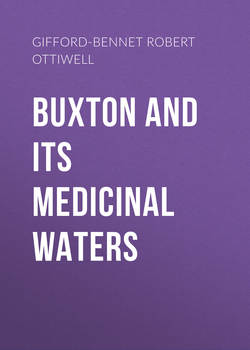Buxton and its Medicinal Waters

Реклама. ООО «ЛитРес», ИНН: 7719571260.
Оглавление
Gifford-Bennet Robert Ottiwell. Buxton and its Medicinal Waters
PREFACE
CHAPTER I. TOPOGRAPHICAL AND DESCRIPTIVE
CHAPTER II. THE MEDICINAL WATERS AND THEIR ACTION
CHAPTER III. THE BATHS AND MODE OF APPLICATION
CHAPTER IV. DISEASES IN WHICH THE WATERS ARE USEFUL
Отрывок из книги
The ancient town of Buxton, which is situated upon the extreme western boundary of the county of Derby, at an elevation of 1,000ft. above the sea level, lies in a deep basin, having a subsoil of limestone and millstone grit, and is environed on every side by some of the most romantic and picturesque scenery in the High Peak, hill rising above hill in wild confusion, some attaining an altitude of from 1,900ft. to 2,000ft.
Buxton, or, as originally called, Bawkestanes, was occupied as a military station by the Romans, who, during their occupancy, constructed baths over the tepid water springs which issue through fissures in the limestone rock, where it comes in contact with the millstone grit, as was proved beyond doubt by the finding of Roman tiles (used in the construction of their baths) some years ago, when the present baths were under repair.
.....
The natural incline upon which the town is built greatly facilitated the sewerage arrangements so ably planned and successfully carried out by the late Sir Robert Rawlinson.
Two lines of railway, the London and North-Western and Midland, whose stations are situated adjoining each other to the east end of the town, and between Buxton and Fairfield, afford every facility of communication with all parts of Great Britain and Ireland. The station of the East to West Railway now in process of formation will be in Higher Buxton, and will doubtless prove of much convenience to residents in that neighbourhood.
.....